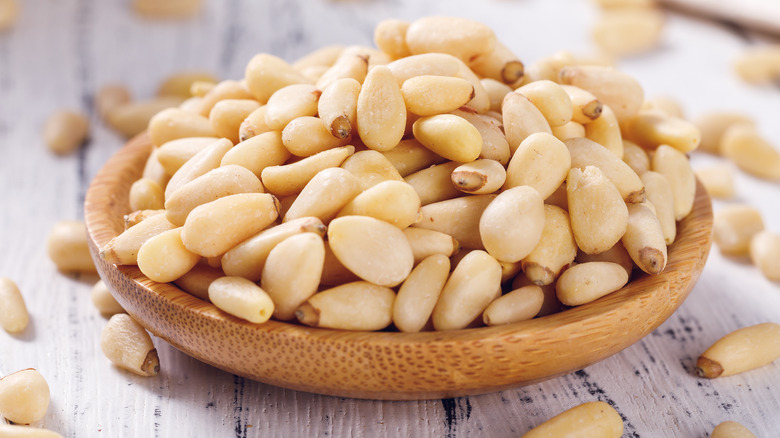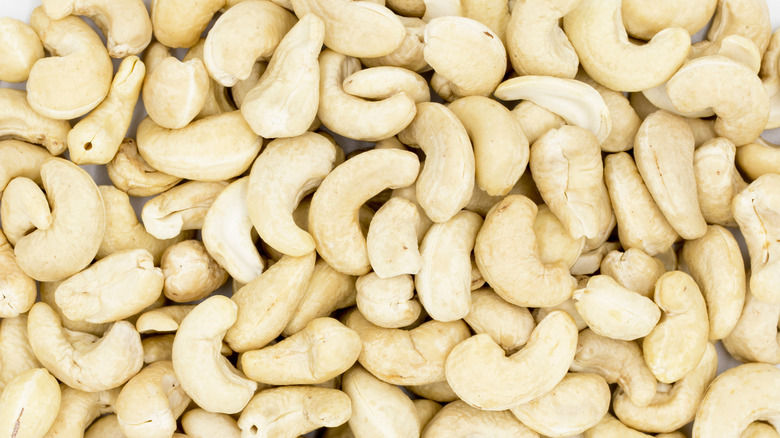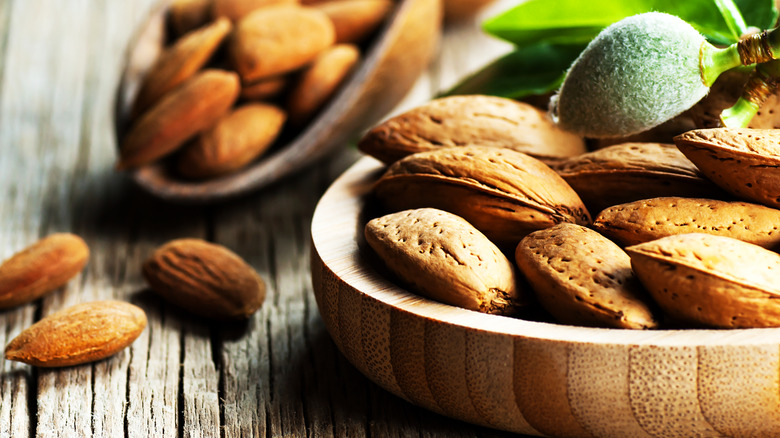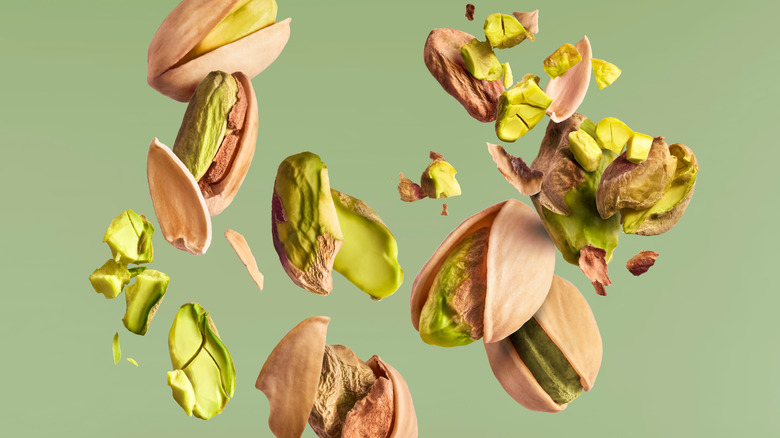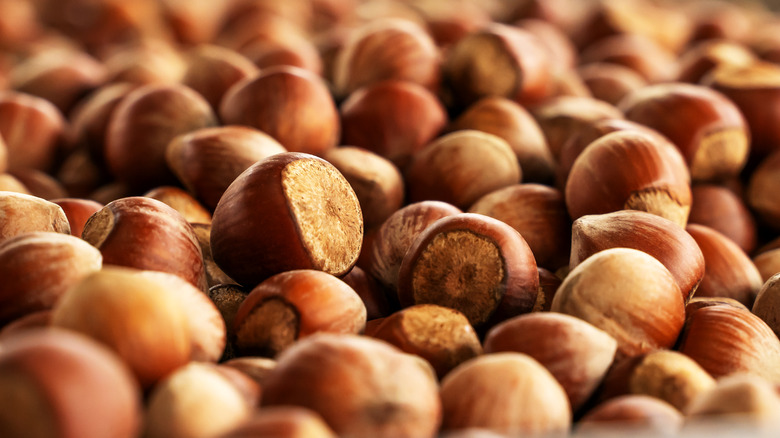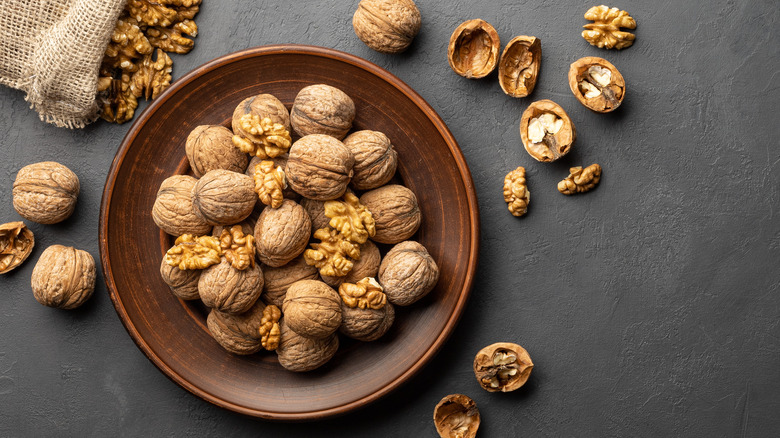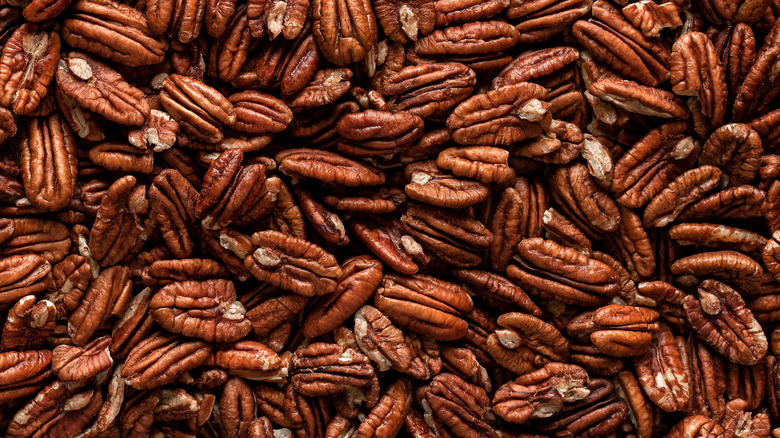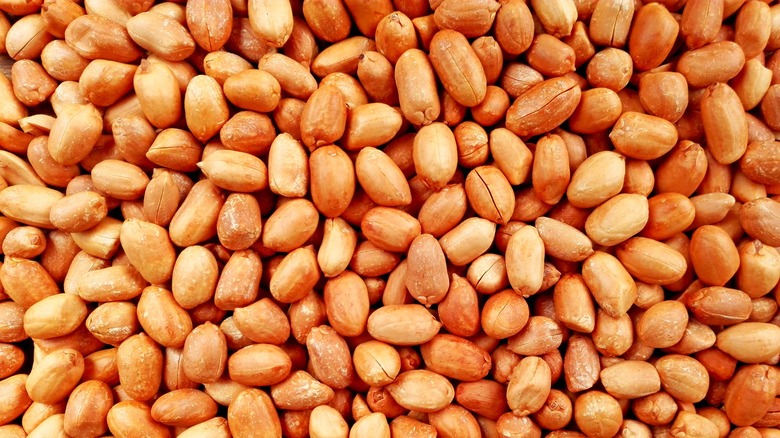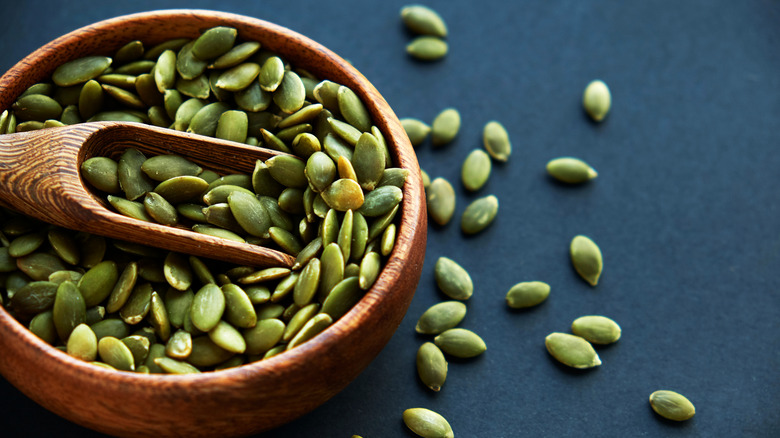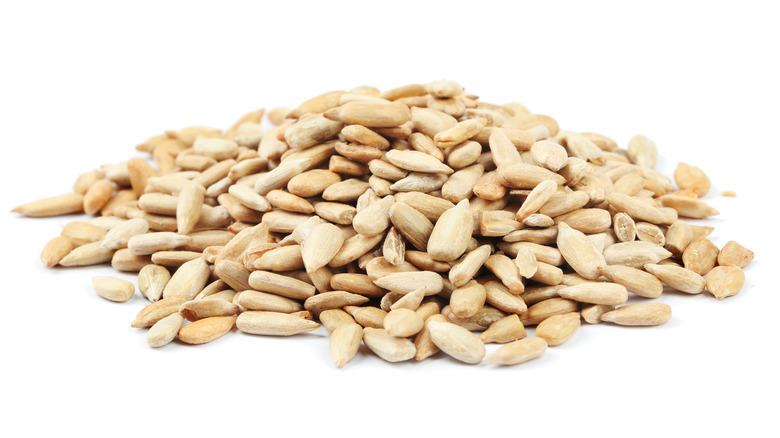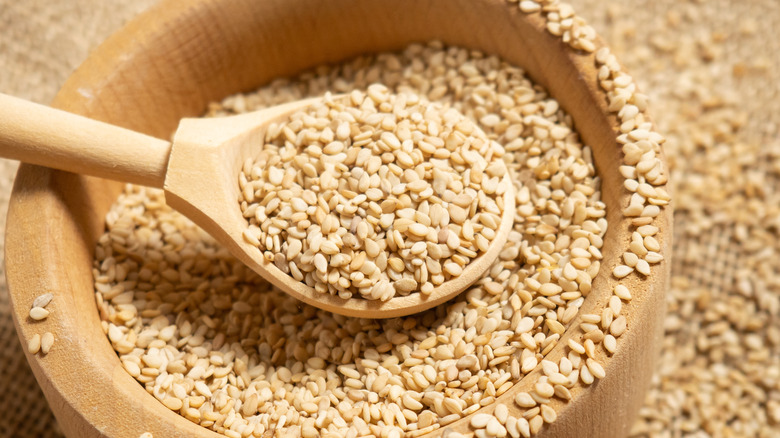10 Best Substitutes For Pine Nuts
There's no doubt that pine nuts help make the creamiest pesto, and rightfully so as, right behind macadamia nuts, they are the second most expensive nut in the world. These small nuts will set you back about $23 per pound because of how long they take to grow (via Money Inc).
Spending a big chunk of your grocery budget on pine nuts every other week may be out of the question, especially when you can substitute them for other less expensive nuts. You can substitute pine nuts with other seeds or nuts depending on what you're planning to use them for. Whether it's the lush creaminess you want for a smooth pesto, or the faint nutty sweetness that it can add to desserts, as long as you know what you're doing with the pine nuts, there's an easy swap that will do an equally fine job.
There is another bonus to swapping this nut for another ingredient — in addition to saving money, you'll avoid pine mouth, the metallic aftertaste some people get after eating pine nuts (via Bon Appétit).
1. Cashews
Not only do cashews have a similar color to that of pine nuts, but cashews have a similar texture and add the same subtle sweetness to foods that pine nuts do. Cashews work as a healthy alternative to pine nuts as they are a good source of fiber and protein, as well as other nutrients like copper and manganese, which can improve brain and bone health (via Healthline).
If it's a pesto that you're making, a couple cooks claim that cashews work especially well in place of pine nuts. To make the most of your cashews, the outlet recommends chopping and then toasting them in an ungreased pan for a few minutes until they're slightly brown, as doing so will bring out the nutty flavor from cashews which resembles that of pine nuts.
If you're sprinkling toasted cashews on top of salads or pasta as you would with pine nuts, you could chop the cashews into half-inch size pieces too. Per Greedy Gourmet, to substitute pine nuts with cashews you should add 1 ½ tablespoons of cashews for every tablespoon of pine nuts.
2. Almonds
While pine nuts are expensive and comparatively harder to find, a substitute that you're more likely to have stocked in your pantry is almonds. Although almonds don't have the same punch as pine nuts do in terms of flavor, much like cashews, toasting does a good job of bringing the nuttiness out (via a couple cooks). Adding more almonds to your diet is a plus, as they can help regulate blood sugar levels and lower bad cholesterol (via Healthline).
Soaking almonds overnight and peeling off the skin before using them in your recipe will work best, as soaked almonds will be softer and closer to the texture of pine nuts. Healthline notes that soaked almonds can be easier to digest and are more buttery in flavor than raw almonds.
Almonds can be used in place of pine nuts to make pesto and also add a nice crunch topped on salads and pasta dishes. To substitute pine nuts with almonds, Greedy Gourmet recommends using a 1:1 ratio.
3. Pistachios
Pine nuts are used as ingredients in their own right to add on top of meats and vegetables, in pan sauces, in stuffing, or folded into batters to make desserts. Another nut that makes a frequent appearance in cooking alongside pine nuts and almonds is the pistachio.
The pistachio is a no-brainer when it comes to looking for a pine nut alternative, especially in pesto, as the nut's naturally green hue will add to the sauce's much sought-after color. Pistachios also fair well in desserts due to their subtle sweetness. When swapping nuts for desserts, however, make sure to use unsalted pistachios to ensure the flavor isn't overcome by salt. Pistachios have a flavor noticeably distinct from that of pine nuts so, in terms of taste, your dish may turn out equally delicious, but with a more obvious flavor of pistachios.
Greedy Gourmet suggests substituting one tablespoon of pine nuts with 1 ½ tablespoons of pistachios.
4. Hazelnuts
Hazelnuts tend to be used often in Italian and Mediterranean recipes so they make for an excellent substitute to pine nuts. Due to its sweet taste, Substitute Cooking suggests going for hazelnuts in sweeter recipes more than savory ones, especially when working with chocolate. After all, hazelnut is what Nutella is made from.
While you can use hazelnuts without toasting them, if you want more of the nut's flavor and aroma — toast them first. Hazelnuts may not be for everyone as the skin of hazelnuts makes the nut quite bitter. Instead, blanch them first by boiling them in hot water, then peel off the skin before chopping them and adding them to your recipe.
Hazelnuts have a much stronger taste than the subtle flavor of pine nuts which is why Greedy Gourmet recommends using a smaller quantity than you would pine nuts. For best results, use ½ a tablespoon of hazelnuts for every tablespoon of pine nuts required in your dish.
5. Walnuts
Not only are walnuts less expensive as compared to pine nuts but they're incredibly versatile. You can use walnuts as an alternative to pine nuts in pretty much any recipe including salads, pastas, and desserts. In fact, per Substitute Cooking, the go-to pine nut alternative for Italians happens to be walnuts, especially in pesto.
It also helps that walnuts are packed with so many nutrients including omega-3s, vitamin E, and antioxidants. Healthline further reports that an annual walnut conference takes place each year where walnut experts and scientists gather at the University of California to discuss the latest updates on the health benefits of walnuts. Who knew?
It's recommended to roast the walnuts first, peeling off the skin to get rid of some of the bitterness, and then soaking the nuts overnight to turn them into a soft and creamy pesto. Due to the bitter taste of walnuts, Greedy Gourmet suggests using ½ tablespoon of walnuts for every tablespoon of pine nuts that your recipe calls for.
6. Pecans
Another nut that can be used in all sorts of recipes where pine nuts typically shine is the pecan. Pecans have a distinct sweet and butter-like taste, so they fare particularly well in desserts like cakes, breads, cookies, and ice cream (via Recipe Marker). When using pecans in place of pine nuts in ice cream, roasting the nuts in some honey, grinding them up, and then churning the mixture into ice cream works especially well.
Substitute Cooking finds that pecans contain more natural oil than other nuts and so, they tend to be oiler than pine nuts. When grinding pecans into a smooth paste to use in pesto, be prepared for there to be way more oil than you expect, and make sure to tweak the amount of olive oil you use accordingly.
To use pecans as a pine nut alternative, use ¾ of pecans to the number of pine nuts required in your recipe.
7. Peanuts
When it comes to the cheapest and the most readily available alternative to pine nuts, peanuts take the cake. Cuisine Vault compares the taste of raw peanuts to that of uncooked peas with a smooth and buttery flavor, and although delicious, the site doesn't recommend using peanuts as a substitute for pine nuts in pesto. Besides, there are far better alternatives to pine nuts in pesto recipes that will make your dish equally nutty. Instead, peanuts work better in baked foods such as cookies and cakes, as well as in stir-fry dishes and salads. When doing so, make sure to use unsalted peanuts instead of salted ones.
Peanuts are a great source of protein, packed with essential vitamins and minerals, and full of healthy fats while being fairly low in carbs (via Healthline).
For best results, Greedy Gourmet recommends using ½ tablespoon of peanuts for every tablespoon of pine nuts required in your recipe.
8. Pumpkin seeds
Swapping pine nuts for others with a similar flavor profile may be a no-brainer, but there are some seeds that you can use as well. Pine nuts do resemble seeds more in appearance than nuts after all. Using seeds, like pumpkin, have the added advantage of making your dish suitable for anybody with nut allergies.
Pumpkin seeds can be used in pretty much any pine nut recipe and in any form — plain, salted, roasted, or raw (via Substitute Cooking). When using pumpkin seeds as an alternative for pine nuts in pesto, be careful of your pesto's consistency. As with pecans, pumpkin seeds too tend to have more oil than pine nuts and so, your pesto can be oilier than you want it to be. Make sure to adjust the amount of olive oil that you add to your pesto when using pumpkin seeds.
To use pumpkin seeds for pine nuts, use ½ tablespoon of pumpkin seeds for every tablespoon of pine nuts required in your dish.
9. Sunflower seeds
As with pumpkin seeds, sunflower seeds offer a nut-free alternative to pine nuts for anyone with nut allergies. The fruits of sunflowers, these seeds have an inherently subtle nutty flavor, much like pine nuts (via Healthline). Sunflower seeds are a good source of vitamin E and antioxidants. Adding them to your daily diet can help regulate blood pressure, lower your blood sugar and cholesterol, and can add much-needed protein to your day.
The seeds are excellent when used in breads and salads, however, they're not the best pine nut alternative when it comes to pesto. Per Greedy Gourmet, the grey color of sunflower seeds can easily make your pesto grey in color which will look nothing like the vibrant green that you want your sauce to be. When it comes to pesto, it's probably best to stick to other more suitable pine nut substitutes.
For best results, use equal amounts of sunflower seeds for pine nuts in your recipe, a 1:1 ratio.
10. Sesame seeds
Here's a substitute that you probably wouldn't think of as a close alternative to pine nuts — sesame seeds. Long used as the key ingredient to making tahini, which is a staple in Middle Eastern and Mediterranean cuisines, the small seeds act as a base for hummus. Sesame seeds turn into a beautiful paste when ground up.
While sesame seeds do make an excellent earthy and grainy paste, it's not recommended using them in place of pine nuts when making pesto, as it has a drastically different texture and flavor.
Instead, the site recommends using sesame seeds in any dish where pine nuts are used as a flavor enhancer alongside other bold ingredients, rather than the star ingredient: Think salads, sauces, and desserts. You could also toast the sesame seeds first to further bring out the flavor (via Substitute Cooking).
To substitute pine nuts with sesame seeds, use 2 tablespoons of sesame seeds for every tablespoon of pine nuts that your recipe calls for.
